MXA RACE TEST: THE REAL TEST OF THE 2022 KAWASAKI KX112 SUPERMINI
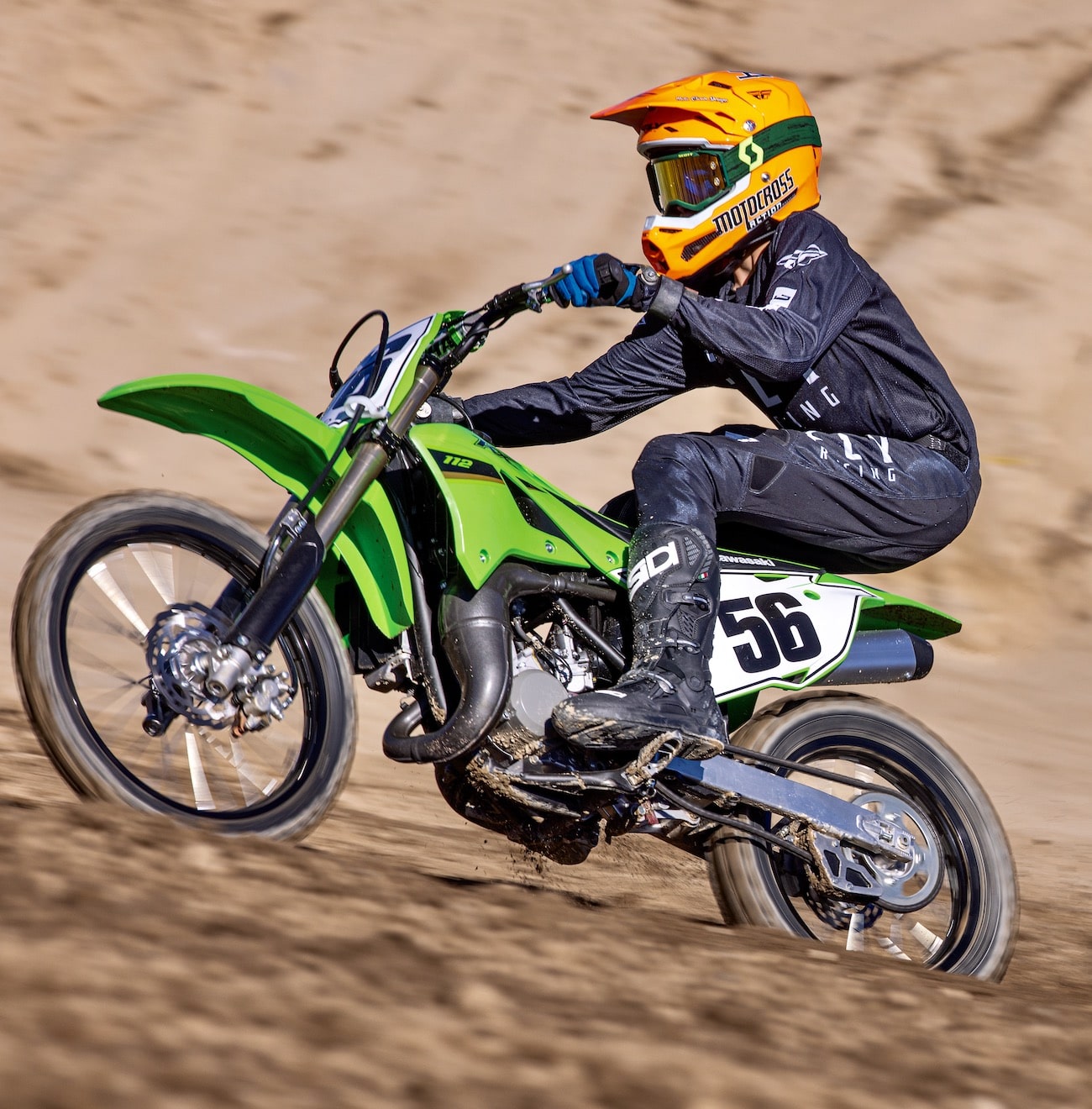 THE GEAR: Jersey: Fly Racing Kinetic Mesh, Pants: Fly Racing Kinetic Mesh, Helmet: Fly Racing Formula, Goggles: Scott Prospect, Boots: Sidi Atojo.
THE GEAR: Jersey: Fly Racing Kinetic Mesh, Pants: Fly Racing Kinetic Mesh, Helmet: Fly Racing Formula, Goggles: Scott Prospect, Boots: Sidi Atojo.
Q: IS THE 2022 KAWASAKI KX112 BETTER THAN THE 2021 KX112?
A: Well, yes and no. No, because there isn’t a 2021 version to compare it to. Yes, because it’s better than the KX100, which is the platform this bike came from. New for 2022, Kawasaki has made significant updates to its KX85 and transformed the KX100 into a KX112 with a new engine and more.
Q: WHAT IS A KAWASAKI KX112 SUPERMINI?
A: The 2022 Kawasaki KX112 is a bigger and faster version of the KX85, built specifically for riders between 12 and 16 years old who are racing in the Supermini class. The KX85 retails for $4599 and has the same frame, subframe and plastics as the KX112, which retails for $5099. The KX112 is 2 inches taller than the KX85, 4 pounds heavier, and has bigger wheels and a bigger engine.
Q: WHAT STANDS OUT ABOUT THE KAWASAKI KX112?
A: The KX112 is one of only two Supermini-specific bikes on the market that come with the engine already built out to 112cc, which is the maximum displacement limit for the Supermini class. Any riders looking to race the Supermini division on a Yamaha, KTM, Husky, GasGas or Suzuki will have to modify their 85cc in the aftermarket to get the same displacement as Kawasaki. TM Racing is the only other brand that also makes a 112cc Supermini in stock form.
The KX112 is a “big wheel” model that comes with an extended swingarm, 19-inch front wheel and 16-inch rear. Standard 85cc minibikes come with 17-inch front and 14-inch rear wheels. Interestingly enough, Yamaha, KTM, Husky and GasGas each sell a big wheel version of their 85 to run in the Supermini class, but little Johnny’s dad has to install a big-bore kit himself. KTM sells a 105cc big-bore kit, and Athena and other aftermarket brands sell big-bore kits for the Yamaha YZ85.
Q: WHO IS THE KAWASAKI KX112 MADE FOR?
A: Kawasaki’s marketing slogan is, “The bike that builds champions.” Considering that Ricky Carmichael, James Stewart and Ryan Villopoto all rode for Team Green in their amateur days, that slogan does technically ring true. In the latest wave of minibike stars, names like Adam Cianciarulo and Austin Forkner are also Team Green alumni. The next wave is Jett Reynolds and Ryder Difrancesco, both popular amateur riders who’ve won countless Loretta Lynn Championships for Kawasaki on mini bikes and now 250 four-strokes.
None of the riders named had access to the KX112, because it wasn’t available yet. Each of these riders spent time on the KX85, and for the Supermini classes, they used the KX100 with aftermarket upgrades from Mitch Payton and Pro Circuit to bore out their engines to 112cc.
The KX112 is made specifically for experienced minibike racers who are almost ready for a 125 two-stroke or 250 four-stroke but still want to compete in the mini ranks. For most kids who aren’t serious racers or who aren’t tall, the KX85 is the perfect bike. For those kids who want to race the Supermini class and/or are too big for the standard KX85, this bike is for them.
Q: HOW DID KAWASAKI COME UP WITH A 112cc ENGINE?
A: Kawasaki used its KX100 model as a base and massaged it. The KX112 engine uses the same 52.5-millimeter bore as the KX100 but with a stroke that was increased by 5.8mm to achieve the 112cc displacement. The longer stroke contributes to stronger low-end torque and about 5 percent more horsepower. The KX112 also features revised intake and exhaust port timing, a revised piston profile to increase durability, and a redesigned contact surface for the piston ring to improve initial bedding-in performance. The new KX112 also gained a longer connecting rod (from 92 to 99mm) to reduce the lateral force on the piston for more efficient power. Plus, the needle bearings, crankshaft, carburetor settings and water jacket have been updated as well.
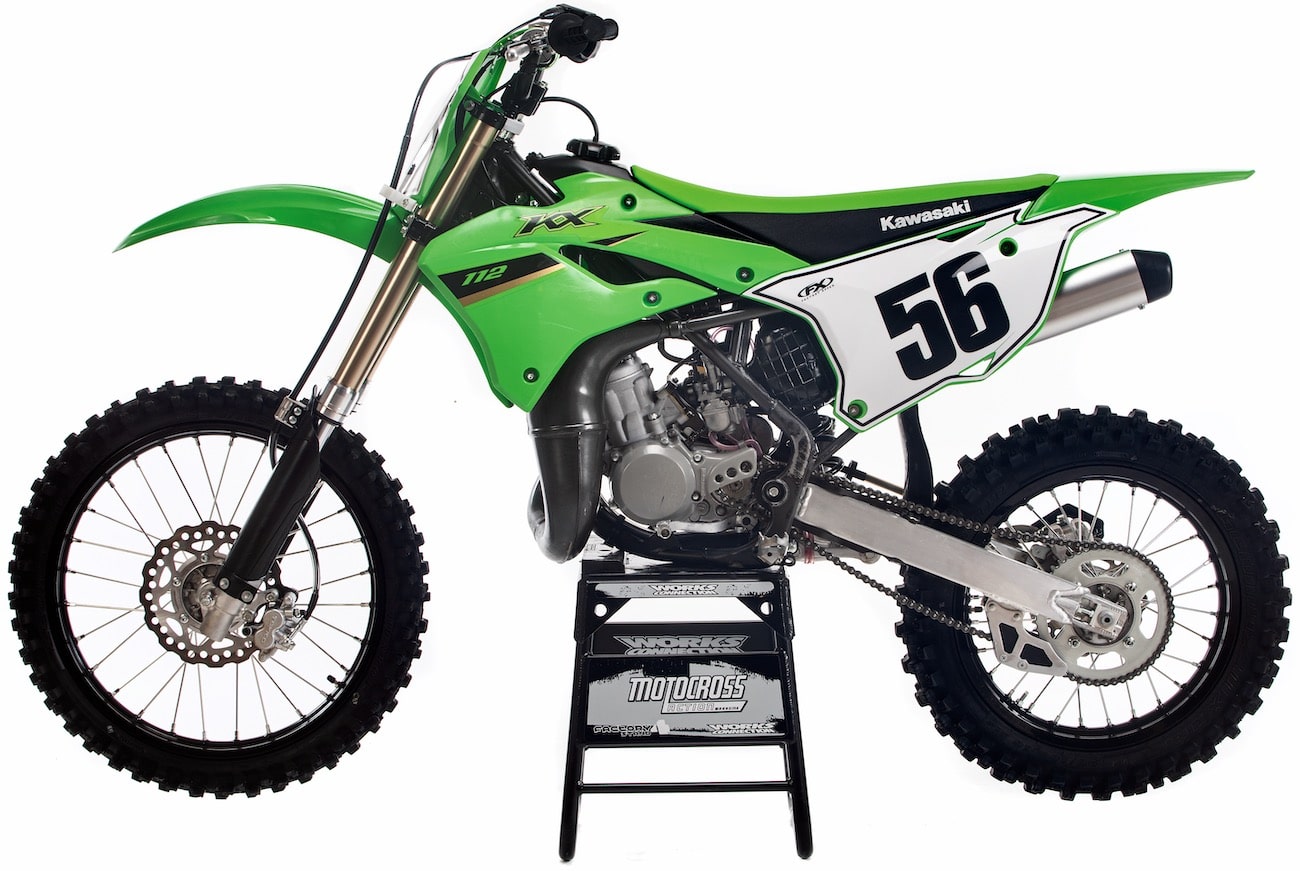 The KX112 engine uses the same piston as the previous KX100 engine but with a longer stroke, long rod configuration and stronger transmission.
The KX112 engine uses the same piston as the previous KX100 engine but with a longer stroke, long rod configuration and stronger transmission.
Q: HOW ARE THE KX112 ERGONOMICS?
A: Most MXA test riders are too big for the KX112, but we were able to find two 14-year-old test riders who are currently racing Superminis to help us with this test. Both riders currently ride KTM 85s and 105s, and one of our testers spent multiple years on the KX85 before making the switch. This helped speed up our KX112 learning process.
The cockpit on the KX112 is significantly tighter than it is on KTM 85SX, which made both of our testers feel cramped. Obviously, a taller rider will feel more cramped and a shorter rider will like the smaller bike; however, most 13-, 14- and 15-year-olds are mid-growth spurt when riding the Supermini division, and they typically appreciate the bigger feel of the KTM.
Once we positioned the stock handlebar mounts in the forward position with the two handlebar raising spacers that Kawasaki provides, the cockpit was better. Still, our test riders wanted more room, so we installed taller and wider handlebars to help them move around easier.
Q: HOW DOES THE KX112 HANDLE?
A: Our mini testers liked the KX112’s ability to carve through corners, and they felt comfortable with the stock suspension settings through acceleration bumps. In stock trim, with the front forks positioned flush in the triple clamps, our testers felt that they weren’t getting enough front-end traction in the turns. To put some more weight on the front end, we raised the forks 6mm, and this helped the bike turn easier through sweeping corners. Our testers also felt that the KX112 was heavier than their KTMs. The extra weight combined with the smaller cockpit made it more difficult to feel comfortable on the KX112.
Q: HOW DOES IT RUN?
A: The KX112 is smooth on the bottom end and pulls from 7000 rpm to its peak at 11,600 rpm. We brought out a KTM with the 105cc big-bore kit installed to ride back-to-back with the KX112. Coming out of corners, our testers preferred the snap of the KTM 105. The KX112 didn’t have as much bottom-end grunt. Down the straightaways, the KX112 gets up to speed, but on the dyno, it is 1-1/2 horsepower off the KTM from 9500 rpm to 11,600 rpm. The KX112’s peak horsepower is 24.96. The KX112 has more displacement than the KTM 105, but unfortunately, it still gets beats out on both horsepower and torque.
Q: HOW DOES THE KX112 COMPARE TO A KTM?
A: Compared to the KTM, the KX112 is much more affordable. The KX112 is priced at $1100 below the $6699 KTM 85SX, and that’s before you install the $800 105cc big-bore kit to make the KTM competitive in the Supermini class. With the lower price point in mind, Kawasaki is missing some of the performance parts of the KTM. Here’s a list:
(1) Rear brake. On the KTM, you can adjust the rear brake pedal position and amount of free play so that the rider doesn’t accidentally drag the rear brake. On the KX, you can adjust the position but not the free play.
(2) Forks. The Kawasaki has a compression adjuster on the bottom of the fork legs, but is missing rebound clickers. KTM has both.
(3) Shock. The KX112 has low-speed compression and rebound clickers to adjust the feel of the rear end. The KTM has those, plus a high-speed adjuster like all big-bike models, offering more tunability.
(4) Power valve. KTM has an adjustable power valve to easily move the power around.
(5) Clutch. KTM has a stronger clutch.
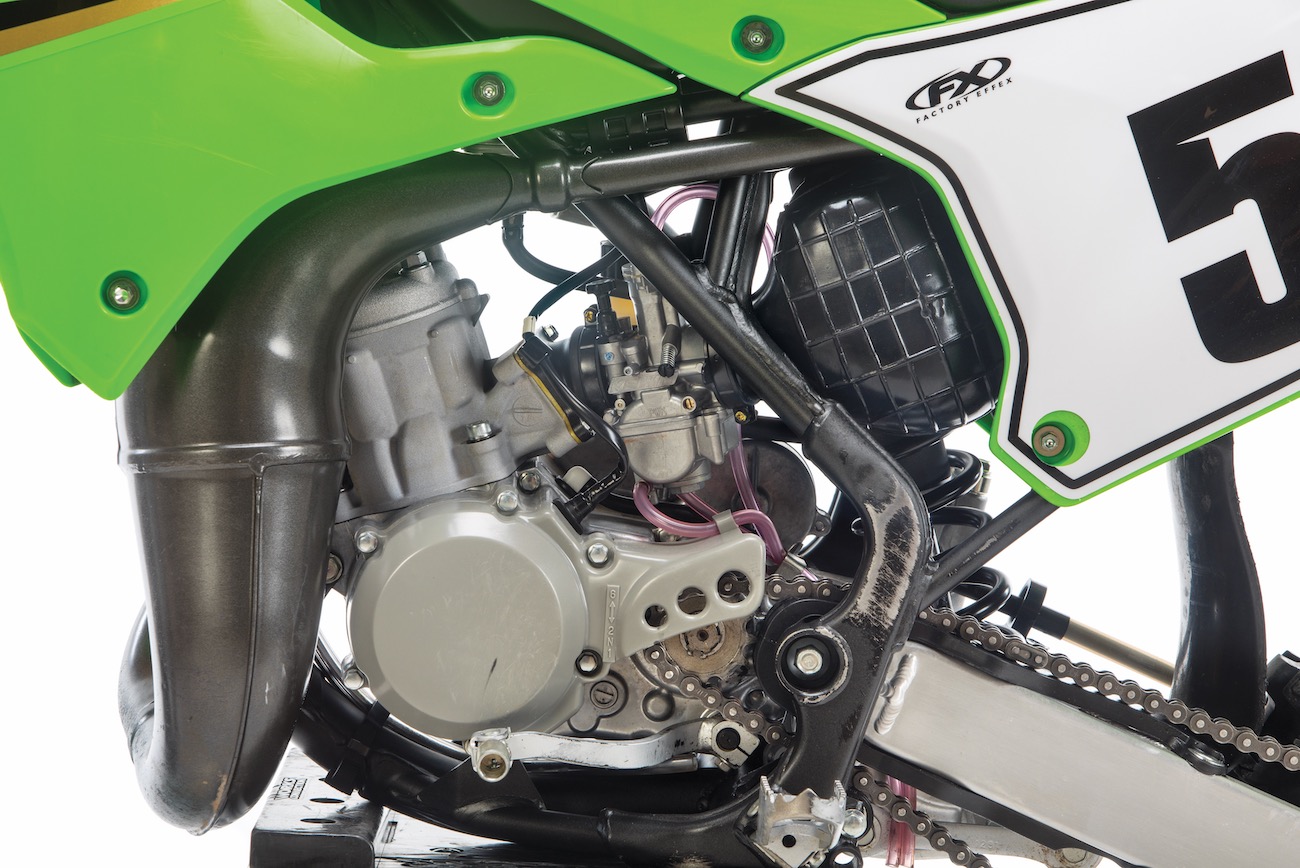 On Kawasaki 85s and Superminis, the pipe comes out of the engine and sweeps around the left-hand side of the bike.
On Kawasaki 85s and Superminis, the pipe comes out of the engine and sweeps around the left-hand side of the bike.
Q: WHAT DOES THE KX112 NEED TO BECOME “RACE-READY”?
A: Here’s a list of things that would help the KX112 become a more competitive race bike in the Supermini class.
(1) Triple clamps. The Kawasaki triple clamps and handlebar mounts are not the bike’s strong points. Although the stock handlebar mounts come with spacers to raise the bars higher, they aren’t enough for most Supermini-sized kids. Pro Circuit makes triple clamps that offer much more adjustment for the handlebars to open up the cockpit. Plus, they don’t bend as easily as the stock triple clamps and handlebar mounts when the bike falls off the stand or the rider tips over in a corner.
(2) Handlebars. The stock KX112 handlebars bend too easily. They sweep too far back, and they are too skinny for most Supermini riders.
(3) Suspension. The stock suspension on the KX112 is too soft for a serious Supermini racer. It needs to be valved stiffer.
(4) Clutch springs. Our testers liked how smooth the KX112 clutch was to pull in, but they needed stiffer clutch springs to prevent the clutch from slipping as it got hot.
(5) Footpegs. Our test riders’ feet were coming off the pegs more than usual. To make this bike race-ready, it needs sharper pegs.
(6) Pipe. We tested a Pro Circuit pipe and silencer on the KX112, and it bumped up horsepower and torque significantly.
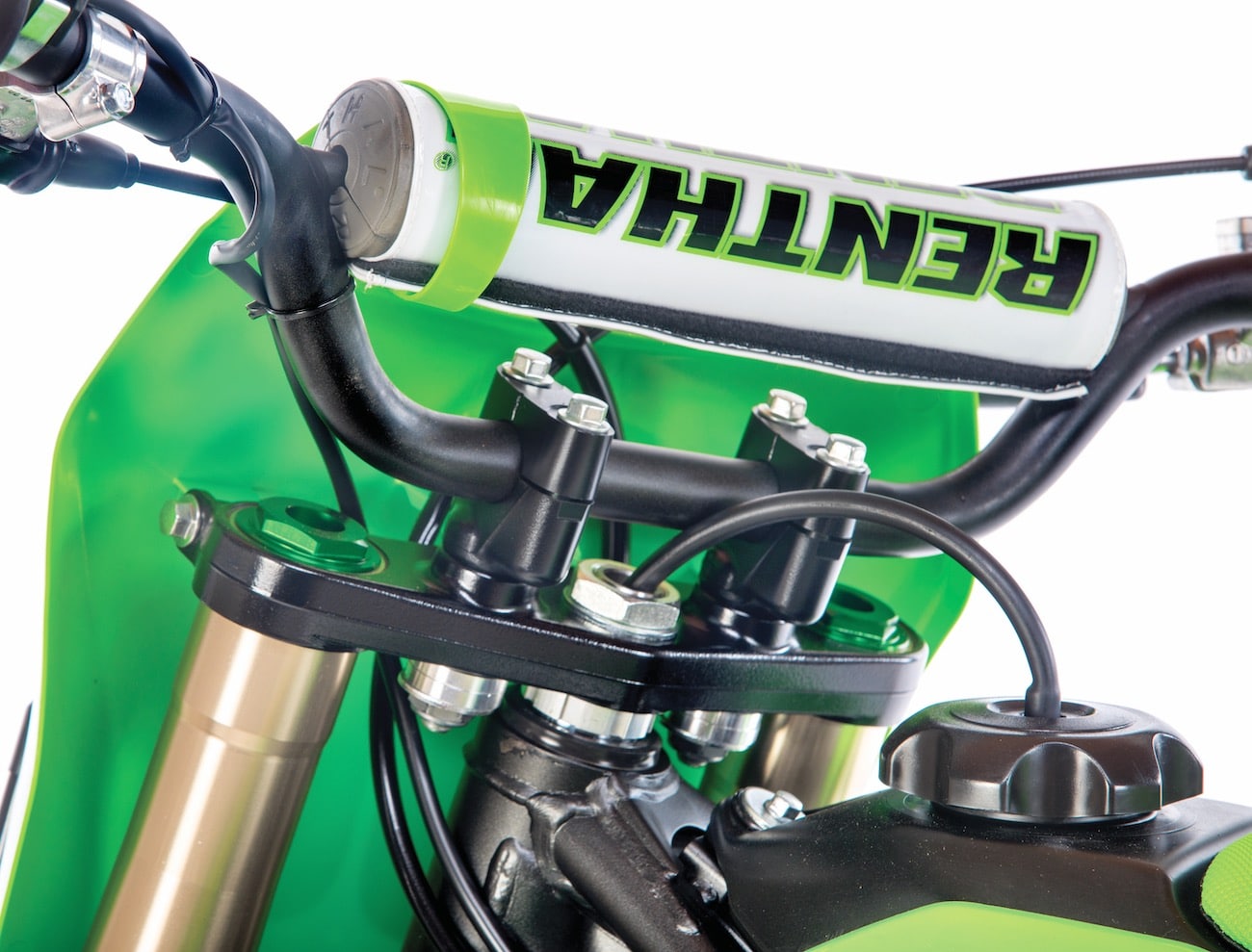 The compression adjuster on the Kayaba forks is on the bottom of the forks lugs. There are only air screws on top.
The compression adjuster on the Kayaba forks is on the bottom of the forks lugs. There are only air screws on top.
Q: WHAT DO WE HATE?
A: The hate list.
(1) Throttle. The throttle cam leverage is too long. It had to be turned too far to get to wide-open throttle. Our test riders wanted a quick-turn throttle to get to wide-open quicker.
(2) Clutch. The clutch needs stronger clutch springs to handle Supermini-type speed.
(3) Frame. The frame doesn’t cradle around the engine as on most bikes. It has one long bottom tube coming from the steering head to the under part of the bike where the linkage and footpegs attach (with two support arms underneath the engine). It only bothers us in the pits; you have to add a custom block to your stand to hold the bike level.
(4) Handlebars. The stock 7/8-inch handlebars and Kawasaki bar mounts both bend super easily.
WHAT DO WE LIKE?
A: The like list.
(1) Updates. It’s very nice of Kawasaki to invest money in its minibike two-stroke line. The industry is growing, and new, updated motorcycles certainly raise excitement levels for the younger generation and their parents.
(2) Engine. Finally, a major manufacturer joined TM Racing and produced a true-to-life 112cc Supermini engine stock.
(3) Price. It’s great that Kawasaki can offer the KX85 and KX112 Supermini within $500 of each other.
(4) Plastics. Although the number plates are sized a little out of proportion, the shrouds have modern styling.
(5) Tires. We like that Kawasaki spec’d Dunlop MX33s.
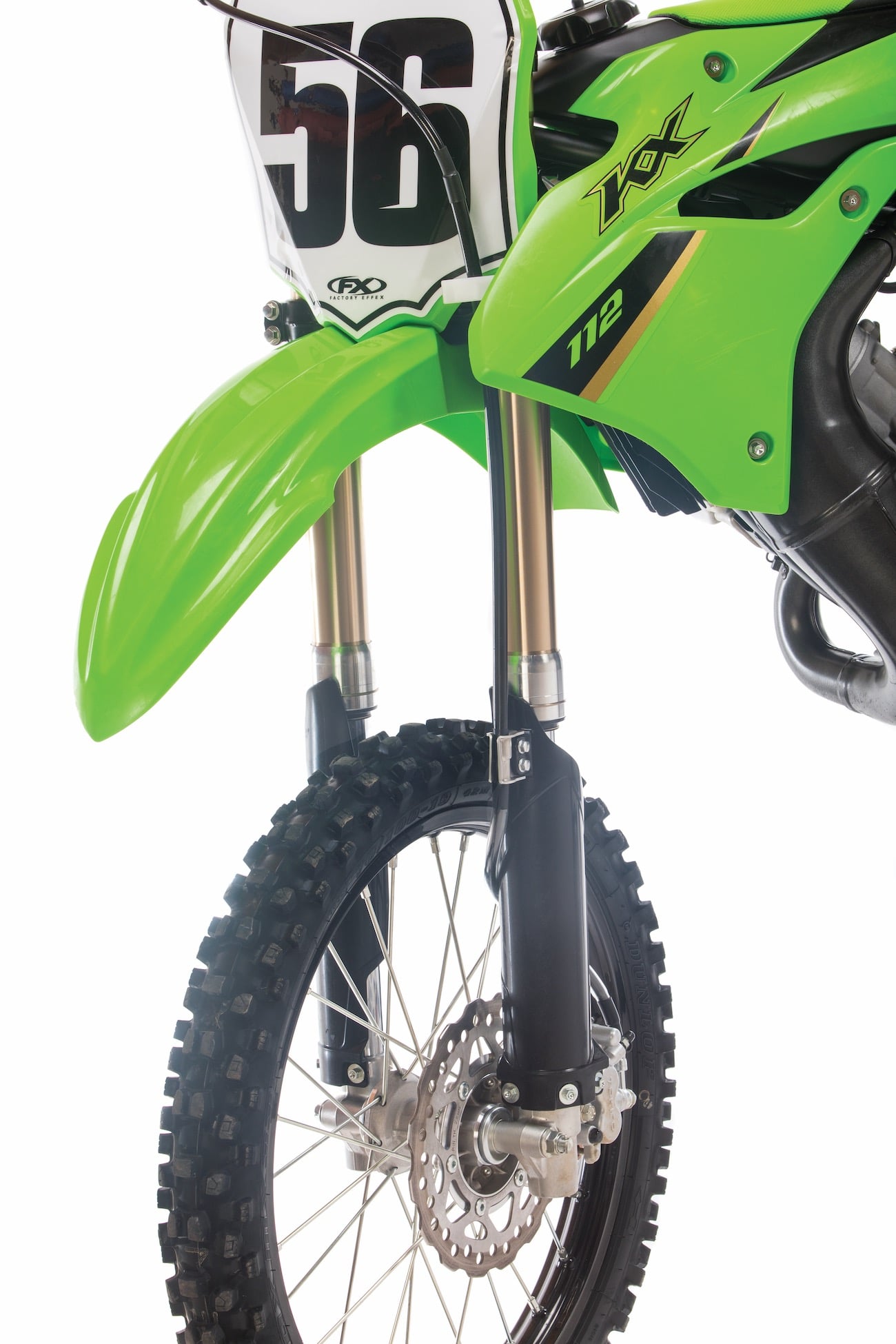 The KX112 comes stock with Dunlop MX33 tires mounted on the “big wheel” rims.
The KX112 comes stock with Dunlop MX33 tires mounted on the “big wheel” rims.
Q: WHAT DO WE REALLY THINK?
A: It’s impressive that Kawasaki built a Supermini-specific bike, because besides the boutique Italian brand TM, Kawasaki is the only other manufacturer with an engine that comes off the showroom floor tailor-made for the Supermini class. No aftermarket big-bore kit is needed; however, the rest of the bike is still at price-point-level quality. We wish Kawasaki had spent more money on the triple clamps, footpegs and suspension settings so that the KX112 would be more competitive with the pumped-up KTM. If you’re going to produce a bike with a full-on Supermini engine, it would be smart to make the whole bike race-ready for Supermini action. This isn’t the type or size bike that the average kid would want. It is a race-specific 112cc machine. We’d be willing to bet that mini dads (especially Supermini dads) would happily spend the extra dough to get little Johnny a true-to-life, race-ready KX112 Supermini.
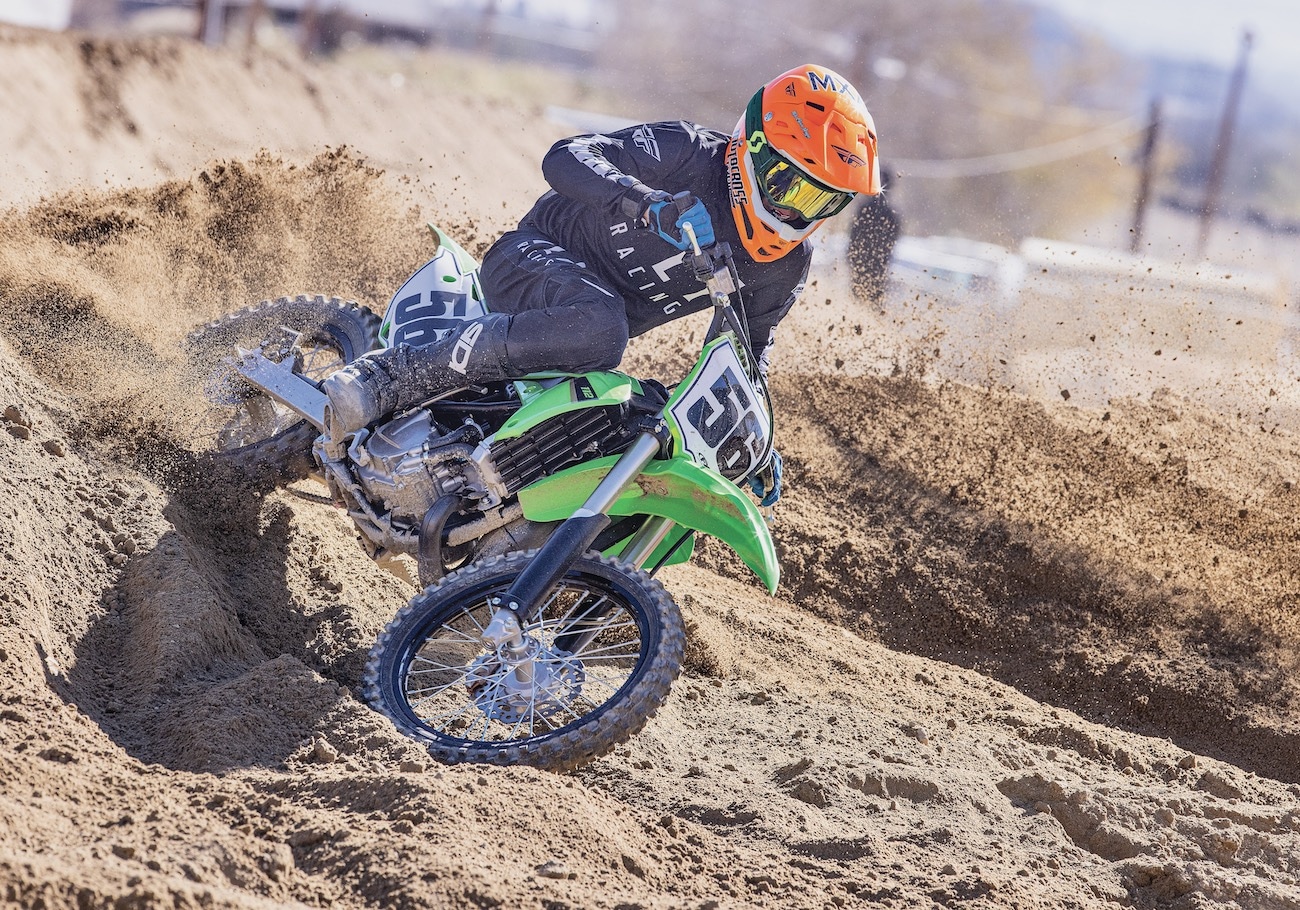 The 2022 KX112 is the first Japanese-made mini with a 112cc Supermini engine. TM Racing is the only other brand that makes a 112 stock.
The 2022 KX112 is the first Japanese-made mini with a 112cc Supermini engine. TM Racing is the only other brand that makes a 112 stock.
MXA’S 2022 KAWASAKI KX112 SETUP SPECS:
This is how we set up our 2022 Kawasaki KX112 for racing. We offer it as a guide to help you find your own sweet spot.
FORK SETTINGS
The stock Kayaba KX112 forks lack rebound clickers. Don’t let the air screw on top of the forks fool you. The compression adjuster is at the bottom of each fork leg, and it is the only clicker you have for adjustment. Other changes can be done by raising and lowering the forks or adding/removing oil. For hardcore racing, this is what we recommend on the 2022 Kawasaki KX112 (stock clickers are in parentheses):
Spring rate: 2.84 N/mm
Compression: 9 clicks out (14 clicks out)
Rebound: N/A
Fork height: 6 mm (0mm)
Notes: The forks were soft for our 95-pound intermediate test riders. We raised the forks in the clamps to get more front-end traction, which helped cornering but made the forks even softer under braking and over jumps.
SHOCK SETTINGS
The Kayaba shock has low-speed compression and rebound adjusters but nothing to manipulate high-speed compression. We slowed down the rebound and left the compression stock for our test riders. For hardcore racing, we ran this setup on the 2022 Kawasaki KX112 (stock settings in parentheses):
Spring rate: 47 N/mm
Race sag: 90mm
Hi-compression: N/A
Lo-compression: 14 clicks out
Rebound: 8 clicks out (11 clicks out)
Notes: Pro Circuit recommends setting the race sag between 80mm and 90mm. If the sag isn’t within those parameters, you’re better off going softer or stiffer on the spring rate.
2022 KAWASAKI KX112 JETTING
The KX112 comes with a 28mm Keihin carburetor. Team Green recommends these jetting specs for its KX112 riders, and we had no issues with them (stock settings are in parentheses).
Main jet: 142 (148)
Pilot jet: 45 (42)
Needle: NAPD (NRKC)
Clip: 3rd position
Air screw: 1-1/2 turns out (1-3/4 turns out)
Notes: This KX112 jetting ran well for us with the stock pipe and silencer and with the Pro Circuit pipe and silencer.


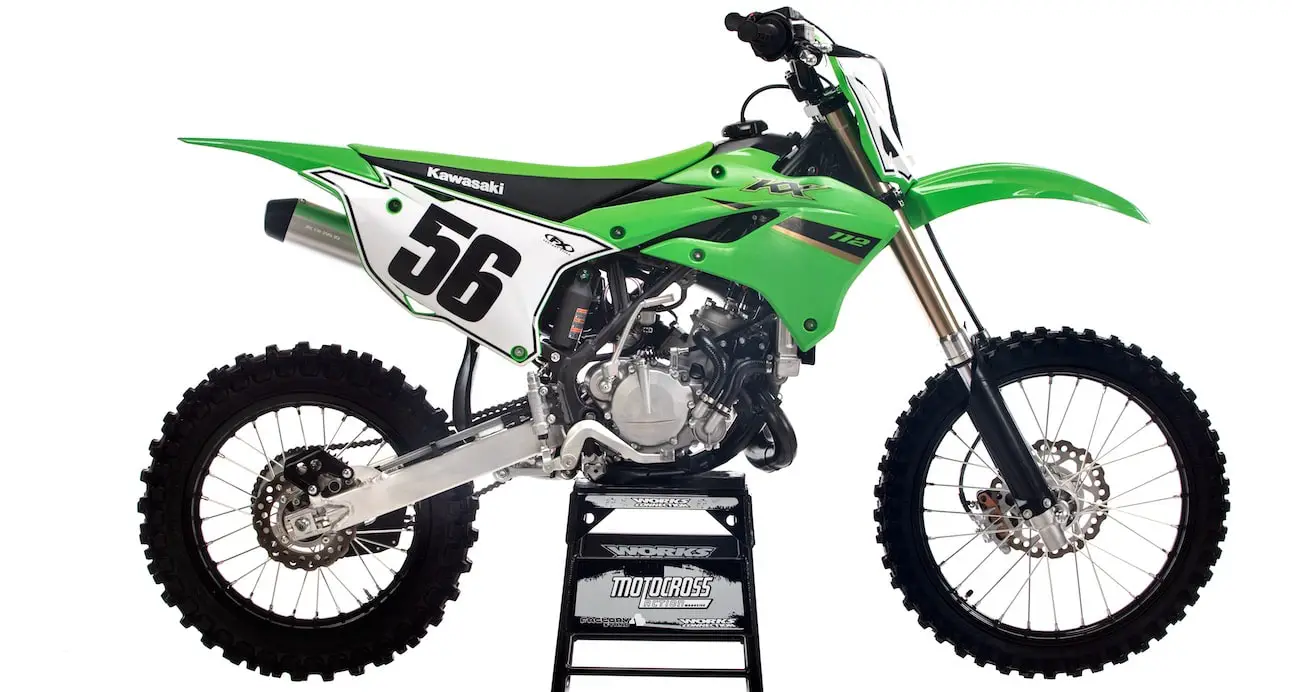
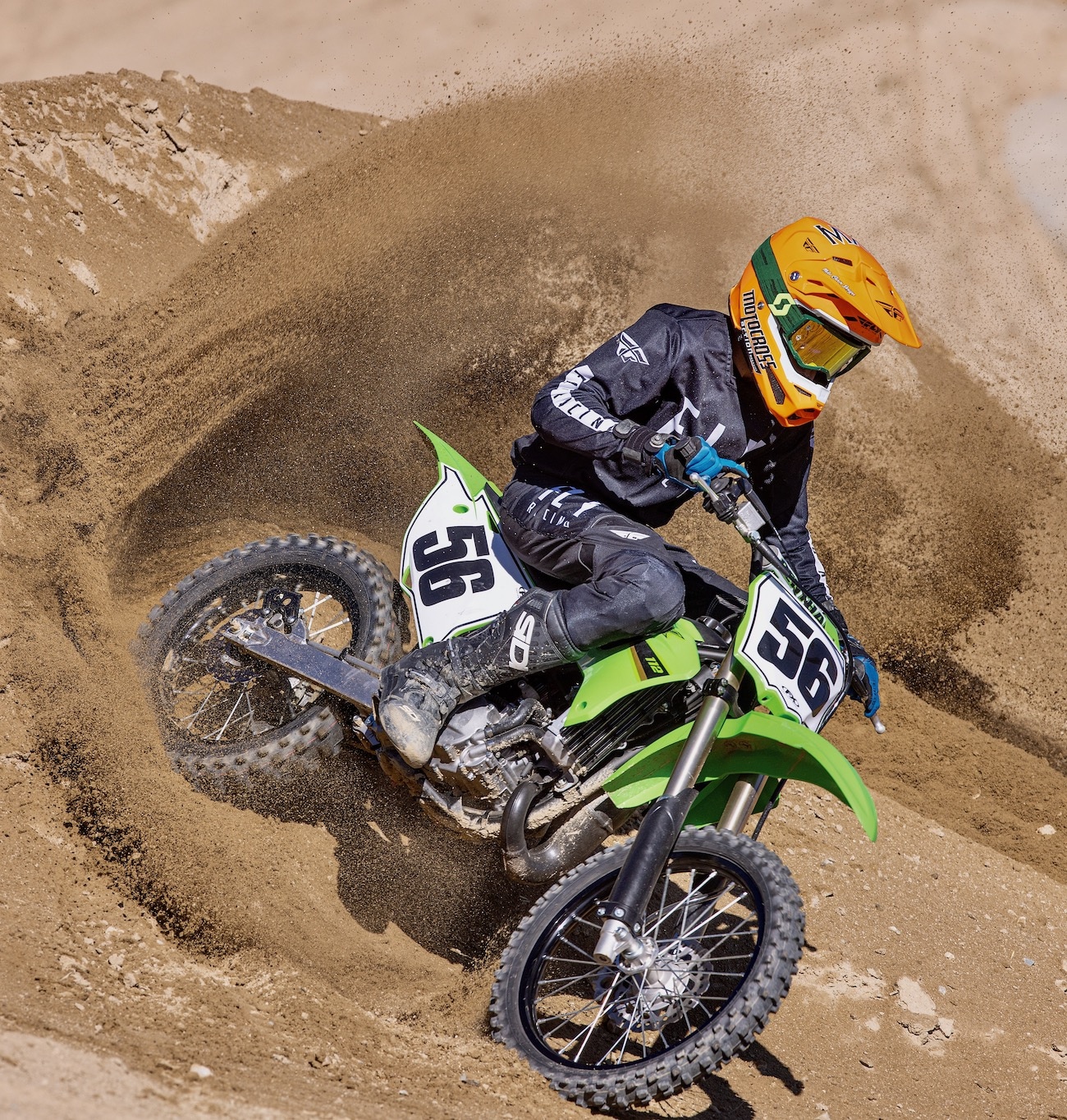
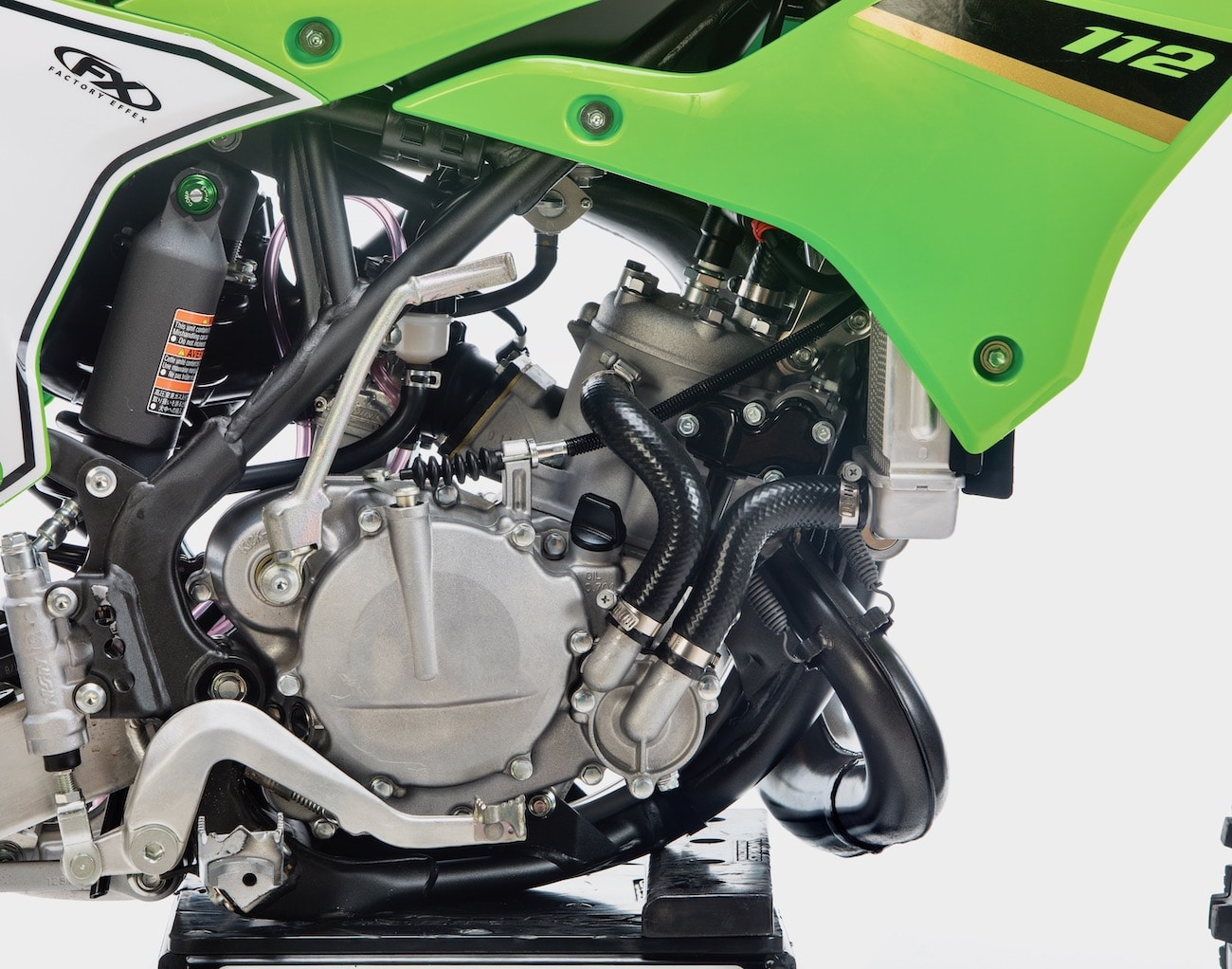





Comments are closed.